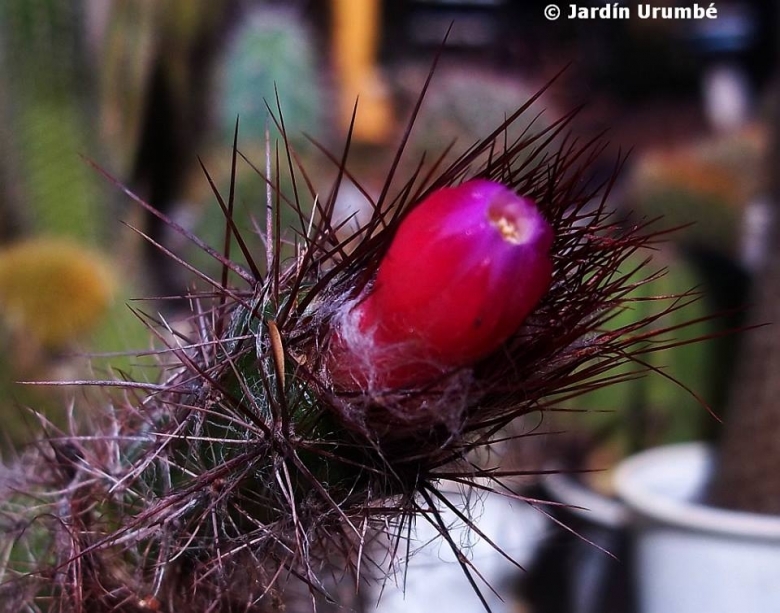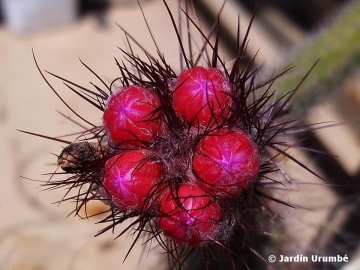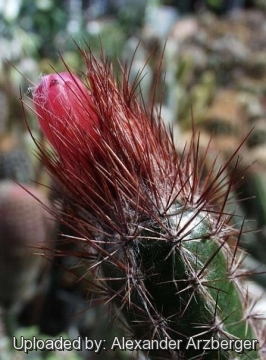Accepted Scientific Name: Arrojadoa dinae subs. eriocaulis (Buining & Bredero) N.P.Taylor & Zappi
Cactaceae Consensus Init. 3: 7. 1997

Arrojadoa eriocaulis var. rosenbergeriana Photo by: Alexander Arzberger
Origin and Habitat: East of Mato Verde, Minas Gerais, Brazil.
Altitude range: 1067 metres.
Synonyms:
See all synonyms of Arrojadoa dinae
back
Accepted name in llifle Database:Arrojadoa dinae Buining & BrederoKakteen Sukk. 24(5): 99. 1973Synonymy: 2
Accepted name in llifle Database:Arrojadoa dinae subs. eriocaulis (Buining & Bredero) N.P.Taylor & ZappiCactaceae Consensus Init. 3: 7. 1997Synonymy: 10
back
Description: Arrojadoa eriocaulisSN|4829]]SN|4830]] var. rosenbergeriana (ayn: Arrojadoa rosenbergerianaSN|4829]]SN|4859]]), is generally included within (as a synonym of) Arrojadoa dinae subs. eriocaulisSN|4859]]SN|4829]], suggesting that there is not really a fundamental difference between the two, and hard to name accurately without knowing where they come from. In particular the var. rosenbergeriana distinguish for the darker and stronger spines. However the distinguishing characteristics of var. rosenbergeriana, appear to fall within the natural variation of Arrojadoa dinae subs. eriocaulisSN|4830]]SN|4829]] and it should be synonymized with the latter, but it still has a value for a collector because they identify plants with particular characters.
Subspecies, varieties, forms and cultivars of plants belonging to the Arrojadoa dinae group
Arrojadoa dinae, Arrojadoa multiflora, Arrojadoa eriocaulis and Arrojadoa beateae are a group of distinct but related species in Minas Gerais and Bahia. They are readily distinguished by their subterranean tubers, stems, wood anatomy, bi-colored flowers, and fruits. Most authors regard them as conspecific under the oldest name Arrojadoa dinae. However some studies in the field, show that it should be better to maintain these taxa as separate species. In some cases they even grow together (A. dinae, A. eriocaulis) without hybridization.
- Arrojadoa beateae P.J.Braun & Esteves
 Arrojadoa dinae Buining & Bredero: (subsp. dinae) has stems up to 30 cm tall, usually with 11 ribs, whitish spines, and brownish carmine flowers with yellow interiors. Distribution: Bahia.
Arrojadoa dinae Buining & Bredero: (subsp. dinae) has stems up to 30 cm tall, usually with 11 ribs, whitish spines, and brownish carmine flowers with yellow interiors. Distribution: Bahia.- Arrojadoa dinae subs. eriocaulis (Buining & Bredero) N.P.Taylor & Zappi: typically has 8-9 ribs, yellowish brown spines, and light violet-pink flowers. Distribution: Minas Gerais.
 Arrojadoa dinae var. nana P.J.Braun & Esteves: this is a smallish form strictly related to Arrojadoa dinae subs. eriocaulis.
Arrojadoa dinae var. nana P.J.Braun & Esteves: this is a smallish form strictly related to Arrojadoa dinae subs. eriocaulis. Arrojadoa eriocaulis var. rosenbergeriana Van Heek & W.Strecker: Distribution: East of Mato Verde, Minas Gerais, Brazil.
Arrojadoa eriocaulis var. rosenbergeriana Van Heek & W.Strecker: Distribution: East of Mato Verde, Minas Gerais, Brazil. Arrojadoa multiflora F.Ritter: has stems, up to 80 cm tall. Ribs 7-8. Flowers inside pale yellowish , outside somewhat ruby. Distribution: Bahia.
Arrojadoa multiflora F.Ritter: has stems, up to 80 cm tall. Ribs 7-8. Flowers inside pale yellowish , outside somewhat ruby. Distribution: Bahia.
 Arrojadoa eriocaulis var. rosenbergeriana Photo by: Alexander Arzberger
Arrojadoa eriocaulis var. rosenbergeriana Photo by: Alexander Arzberger Arrojadoa eriocaulis var. rosenbergeriana Photo by: Alexander Arzberger
Arrojadoa eriocaulis var. rosenbergeriana Photo by: Alexander ArzbergerCultivation and Propagation: This species is not particularly difficult on own roots providing it is given a little extra heat during the winter, but this and all its relatives do best when grafted. Arrojadoas bloom on the forest floor all year-round and are accustomed to receiving lots of summer rain and winter dew, so they never dry out for long in the wild. They most definitely are not desert plants and don't survive if treated as such. In arid climates they fare best in containers, where the roots remain moist longer.
Growth rate: It is a relatively rapidly growing and easily flowering species that will make clumps given the best conditions.
Soils: It likes very porous standard cactus mix soil and can also be grown in orchid bark, or on cork sheets or a tree branch like for epiphytes.
Repotting: Use pot with good drainage.
Watering: It should be watered generously during the growing season, keep drier in winter. Water them less than average if in bigger pots.
Fertilization: Feed with a high potassium fertilizer in summer.
Hardiness: Reputedly sensitive to frost (in his biotope the temperature never drops below 15 ° C), but less so if kept on the dry side prior to, and during, cold weather. However warmth throughout the year will increase the grower's success (not less than 8-12°C during rest season).
Exposition: Outside bright, hot conditions or afternoon shade, inside it needs bright light, and some direct sun. Strong light encourages flowering and heavy wool and spine production.
Uses: It is an excellent plant for container growing. It always looks good and stays small.
Pests & diseases: It may be attractive to a variety of insects, but plants in good condition should be nearly pest-free, particularly if they are grown in a mineral potting-mix, with good exposure and ventilation. Nonetheless, there are several pests to watch for:
- Red spiders: Red spiders may be effectively rubbed up by watering the plants from above.
- Mealy bugs: Mealy bugs occasionally develop aerial into the new growth among the wool with disfiguring results, but the worst types develop underground on the roots and are invisible except by their effects.
- Scales: Scales are rarely a problem.
- Rot: Rot is only a minor problem with cacti if the plants are watered and “aired” correctly. If they are not, fungicides won't help all that much.
Propagation: The Arrojadoas are quite easy to grow from cuttings, seed or (often) graft. Seeds germinate in 7-14 days at 21-27° C in spring, remove the glass cover gradually as the plants develops and keep ventilated, no full sun for young plants! To make a cutting twist off a branch and permit it to dry out a couple of weeks, lay it on the soil and insert the stem end partially into the soil. Try to keep the cutting upright so that the roots are able to grow downward.












